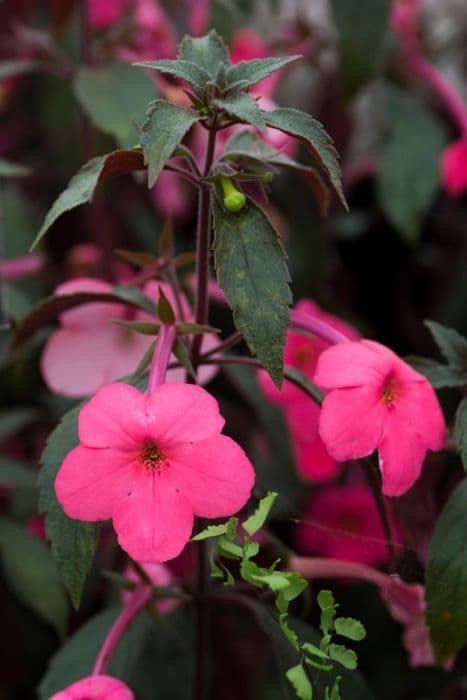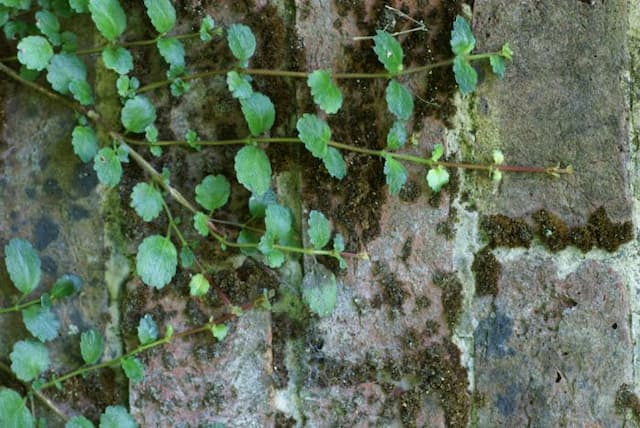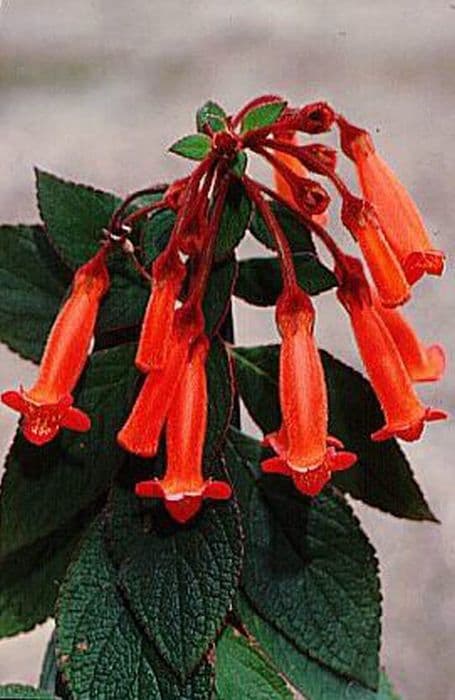Goldfish Plant Columnea × banksii

ABOUT
Columnea × banksii, commonly known as the goldfish plant, is a charming and unique houseplant famous for its striking blooms. The overall appearance of this plant is characterized by a bushy, trailing habit which makes it a favorite for hanging baskets. The stems are slender and may be either upright or cascading, but their most remarkable feature is the abundant flowering. The leaves of the goldfish plant are generally small to medium in size, glossy, and dark green, creating a lush backdrop for the flowers. They are also quite thick and waxy, which is common in plants that are native to tropical environments. The foliage tends to grow densely along the stems, giving the plant a full and vibrant appearance. Blooming mainly in the warmer months, the goldfish plant produces a multitude of interesting flowers that bear a close resemblance to tiny, leaping goldfish. These blooms are tube-shaped, with flaring petal lobes at the end, and they come in vibrant colors such as orange, red, or yellow with sometimes a hint of other shades. The flowers dangle off the stems in a display that is whimsical and eye-catching, adding to the ornamental value of the plant. Overall, the goldfish plant is visually appealing, with a cascade of greenery and colorful blooms that can brighten up any indoor space. Its appearance is tropical and exotic, contributing to its popularity as a decorative houseplant that brings a touch of nature's wonder into the home.
About this plant
 Names
NamesFamily
Gesneriaceae.
Synonyms
Goldfish Plant, Flying Goldfish Plant.
Common names
Columnea × banksii.
 Toxicity
ToxicityTo humans
The plant commonly known as Goldfish Plant, Columnea × banksii, is not known to be toxic to humans. However, it is always advisable to avoid ingesting plant material that is not meant for consumption as individual reactions can vary, and to keep plants out of reach of young children who might chew on them.
To pets
The Goldfish Plant, Columnea × banksii, is also not known to be toxic to pets. Nevertheless, pet owners should prevent pets from chewing on houseplants in general. Even non-toxic plants can cause gastrointestinal upset or other issues if ingested.
 Characteristics
CharacteristicsLife cycle
Perennials
Foliage type
Evergreen
Color of leaves
Green
Flower color
Red
Height
2 feet (0.61 meters)
Spread
2 feet (0.61 meters)
Plant type
Climber
Hardiness zones
10
Native area
Central America
Benefits
 General Benefits
General Benefits- Aesthetic Appeal: The Columnea × banksii, commonly known as the Goldfish Plant, offers vibrant orange and red flowers that resemble tiny goldfish, providing a unique and attractive visual interest to home interiors or shaded outdoor areas.
- Easy to Grow: This plant is relatively easy to care for, making it a good choice for novice gardeners or those who do not have a lot of time to devote to plant care.
- Indoor Decoration: Its trailing stems and glossy green leaves make it an excellent choice for hanging baskets, adding a touch of natural beauty to indoor environments.
- Habitat Enrichment: When grown outdoors, the Goldfish Plant can enhance the local habitat by providing shelter and nectar for pollinators such as hummingbirds.
- Mood Improvement: Like many houseplants, the Goldfish Plant can contribute to a feeling of well-being and reduce stress levels for people in its proximity.
- Education and Hobby: Plant enthusiasts and hobbyists often enjoy cultivating and propagating the Goldfish Plant due to its interesting flowering patterns, making it a subject for botanical interest and learning.
- Supports Biodiversity: By including a variety of plants such as the Goldfish Plant in gardens or home interiors, individuals can contribute to supporting biodiversity.
 Medical Properties
Medical PropertiesThis plant is not used for medical purposes.
 Air-purifying Qualities
Air-purifying QualitiesThis plant is not specifically known for air purifying qualities.
 Other Uses
Other Uses- As a natural dye: The bright colors of Goldfish Plant flowers may be used to create natural dyes for textiles or crafts, although this use is not common.
- In terrariums: Due to its small size and humidity preferences, Goldfish Plant can be a suitable choice for enclosed terrarium environments where its unique shape can be a point of interest.
- As a biological indicator: Because Goldfish Plant thrives in specific humidity and light conditions, it may indicate an imbalance in indoor growing environments if it starts to decline.
- For educational purposes: Horticulture and botany students might use the Goldfish Plant to study epiphytic plant behaviors and characteristics in a controlled setting.
- As a living ornament during festivities: Goldfish Plant can be utilized as a living decoration during certain holidays due to its striking appearance, particularly when in bloom.
- In photography: The unique look of the Goldfish Plant, particularly when flowering, makes it an interesting subject for botanical and macro photography.
- In art and illustrations: Because of its distinctive shape and colors, artists and illustrators may use the Goldfish Plant as inspiration or directly incorporate its likeness in their work.
- In ornamental dish gardens: The Goldfish Plant can be included in dish gardens as a specimen that adds vertical interest.
- In companion planting: Although not widely recognized, Goldfish Plants may be grown alongside other tropical species to create a layered and diverse indoor plant community.
- As a humidity booster: Placing Goldfish Plants in groups can help raise local humidity levels due to their transpiration, beneficial for other nearby humidity-loving plants.
Interesting Facts
 Feng Shui
Feng ShuiThe Columnea × banksii or Goldfish Plant is not used in Feng Shui practice.
 Zodiac Sign Compitability
Zodiac Sign CompitabilityThe Goldfish Plant is not used in astrology practice.
 Plant Symbolism
Plant Symbolism- Endurance: The Columnea × banksii, commonly known as the Goldfish Plant, can symbolize endurance due to its ability to thrive in a hanging basket, continually producing its unique, fish-shaped blooms over time.
- Perseverance: It often represents perseverance because it continues to grow and bloom even when facing the downward pull of gravity, much as one might persist through life’s challenges.
- Abundance: With its clusters of bright, orange flowers that resemble goldfish, the Goldfish Plant can symbolize a feeling of richness and profusion, evoking a sense of plenty.
- Uniqueness: The unique appearance of its flowers can symbolize individuality and the beauty of being different.
 Water
WaterGoldfish Plant, Columnea × banksii, prefers consistent moisture but should not sit in waterlogged soil. Water thoroughly when the top inch of soil feels dry, which typically equates to watering approximately once a week. Depending on the environment, watering frequency may increase, especially in warmer months. Use lukewarm water to avoid shocking the plant's roots, and aim to provide around 16 to 24 ounces of water, ensuring even soil moisture without overflow. During winter, watering can be reduced to when the top couple inches of soil are dry, as plant growth slows down.
 Light
LightGoldfish Plant thrives in bright, indirect light, making east or west-facing windows ideal locations. Direct sunlight can scorch the leaves, while too little light can lead to poor flowering. If natural light is insufficient, supplemental fluorescent or grow lights can provide the right conditions. Ensure the plant receives consistent light, but avoid the harsh midday sun which can damage the delicate leaves.
 Temperature
TemperatureGoldfish Plant grows best in temperature conditions between 65°F and 80°F. It should not be exposed to temperatures below 50°F, as cold drafts or chill can harm the plant. The ideal growing condition would be a stable, warm environment free from sudden temperature changes. Keeping the plant inside the recommended temperature range is crucial for its health and flowering potential.
 Pruning
PruningPruning the Goldfish Plant helps maintain its shape, encourage bushier growth, and remove spent flowers or damaged foliage. Trim lightly after the main flowering period, which is usually in spring, to foster new growth and additional blooming. Prune back up to one-third of the plant if necessary, focusing on leggy stems to promote a more compact form. It's generally ideal to prune annually, but additional light pruning can be done throughout the year as needed.
 Cleaning
CleaningAs needed
 Soil
SoilFor the Goldfish Plant, a well-draining soil mix is essential. A mix of peat, pine bark, and perlite in equal parts usually works well. The soil pH should be slightly acidic to neutral, ideally between 6.1 and 7.5.
 Repotting
RepottingGoldfish Plants should be repotted every two to three years or when they become root-bound. It's best to repot in spring or early summer when the plant is starting its active growth.
 Humidity & Misting
Humidity & MistingGoldfish Plants thrive in high humidity conditions, ideally between 60% to 80%. They benefit from regular misting or a humidifier to maintain moisture in the air.
 Suitable locations
Suitable locationsIndoor
Place in bright, indirect light and ensure high humidity.
Outdoor
Grow in dappled shade; protect from frost and strong winds.
Hardiness zone
10-11 USDA
 Life cycle
Life cycleColumnea × banksii, commonly known as the Goldfish Plant, starts its life cycle as a seed, germinating in warm, humid conditions, typically in porous, well-draining soil. Upon germination, it develops into a seedling with small leaves, and as it matures, it turns into a vegetative plant with long, trailing stems and leaves, revealing its distinctive characteristic growth habit. During its growth, the plant will enter the flowering stage, producing bright orange-red, fish-shaped flowers, usually in the spring and summer seasons. After pollination, which is often aided by hummingbirds in their native habitat, the flowers will set seed. If conditions allow, these seeds can be dispersed to start new plants, repeating the cycle. Over time, the goldfish plant may become leggy and require pruning, which stimulates fuller growth and can be used for propagation to maintain or expand its presence in a garden or home environment.
 Propogation
PropogationPropogation time
Spring-early summer
The Goldfish plant, Columnea × banksii, is typically propagated through stem cuttings. The most favorable time for propagation is during the spring or early summer when the plant is actively growing. To propagate, a healthy stem cutting about 4 to 6 inches (10 to 15 centimeters) long with at least a few leaves should be taken. The cutting is then dipped into rooting hormone, which is optional but encourages root development, and planted into a moist potting mix. It is important to keep the soil consistently damp but not overly wet, and the cutting should be placed in indirect sunlight. Within a few weeks, the cutting should begin to develop roots, after which it can gradually acclimate to brighter conditions and resume normal care.









